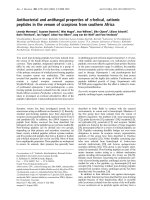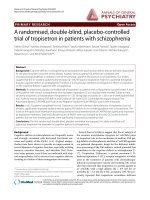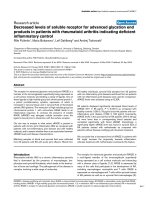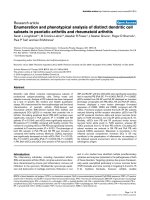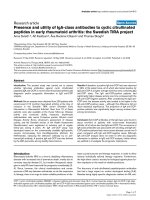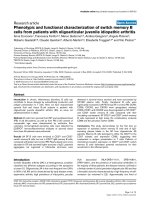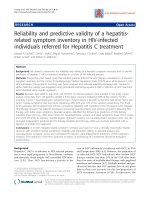Báo cáo y học: "Acute and delayed mild coagulopathy are related to outcome in patients with isolated traumatic brain injury" docx
Bạn đang xem bản rút gọn của tài liệu. Xem và tải ngay bản đầy đủ của tài liệu tại đây (270.32 KB, 7 trang )
RESEARCH Open Access
Acute and delayed mild coagulopathy are related
to outcome in patients with isolated traumatic
brain injury
Sjoerd Greuters
1*
, Annelies van den Berg
1
, Gaby Franschman
1
, Victor A Viersen
1
, Albertus Beishuizen
2
,
Saskia M Peerdeman
3
, Christa Boer
1
, ALARM-BLEEDING investigators
Abstract
Introduction: The relationship between isolated traumatic brain injury (TBI) associated coagulopathy and patient
prognosis frequently lacks information regarding the time course of coagulation disorders throughout the post-
traumatic period. This study was conducted to assess the prevalence and time course of post-traumatic
coagulopathy in patients with isolated TBI and the relationship of these hemostatic disorders with outcome.
Methods: The local Human Subjects Committee approved the study. We retrospectively studied the medical
records of computed tomography (CT)-confirmed isolated TBI patients with an extracranial abbreviated injury scale
(AIS) <3 who were primarily referred to a Level 1 trauma centre in Amsterdam (n = 107). Hemostatic parameters
including activated partial thromboplastin time (aPTT), prothrombin time (PT), platelet count, hemoglobin,
hematocrit, glucose, pH and lactate levels were recorded throughout a 72-hour period as part of a routine
standardized follow-up of TBI. Coagulopathy was defined as a aPPT >40 seconds and/or a PTT in International
Normalized Ratio (INR) >1.2 and/or a platelet count <120*10
9
/l.
Results: Patients were mostly male, aged 48 ± 20 years with a median injury severity score of 25 (range 20 to 25).
Early coagulopathy as diagnosed in the emergency department (ED) occurred in 24% of all patients. The
occurrence of TBI-related coagulopathy increased to 54% in the first 24 hours post-trauma. In addition to an
increased age and disturbed pupillary reflex, both coagulopathy upon ED arrival and during the first 24 hours post-
trauma provided an independent prognostic factor for unfavorable outcome (odds ratio (OR) 3.75 (95% CI 1.07 to
12.51; P = 0.04) and OR 11.61 (2.79 to 48.34); P = 0.003).
Conclusions: Our study confirms a high prevalence of early and delayed coagulopathy in patients with isolated
TBI, which is strongly associated with an unfavorable outcome. These data support clo se monitoring of hemostasis
after TBI and indicate that correction of coagulation disturbances might need to be considered.
Introduction
Acute coagulopathy in the absence of extracranial inju-
ries is a severe complication of traumatic brain injury
(TBI) and may contribute to secondary injury and mor-
tality [1,2]. Among others, brain injury is associated
with activation of the coagulation cascade through ful-
minant cerebral tissue factor release, contributing to dis-
seminated intravascular coagulation and cerebral
microthrombi. This process is independent of bleeding
[3-6]. The subsequent disparity between clot formation
and fibrinolysis in combination with coagulopathy may
increase the risk for delayed or secondary bleeding [7,8].
A recent meta-analysis showed an overall prevalence of
TBI-associated coagulopathy of 33% and a strong rela-
tionship of hemostatic disorders with unfavorable out-
come in these patients [9]. However, the prevalence of
coagulopathy in isolated TBI differed considerably
among studies due to the variety in study design and
definitions of traumatic coagulopathy [9].
* Correspondence:
1
Department of Anesthesiology, Institute for Cardiovascular Research, VU
University Medical Center, De Boelelaan 1117, 1081 HV Amsterdam, The
Netherlands
Full list of author information is available at the end of the article
Greuters et al. Critical Care 2011, 15:R2
/>© 2011 Gre uters et al.; licensee BioMed Central Ltd. This is an open access article distributed under the terms of the Creative Commons
Attribution License ( which permits unre stricted use, distri bution, and reproduction in
any medium, provided the original work is properly cited.
Early recognition of coagulopathy is of value in pre-
dicting the occurren ce of delayed brain injury and may
contribute to prevention of bleeding disorders [10].
Most studies, however, report a mixture of early and
delayed coagulopathy in isolated TBI, and knowledge
about the prognostic value of acute, early diagnosed
coagulopathy is therefore limited. A recent evaluation of
a large German trauma registry revealed that 23% of
patients with isolated TBI are presented with acute coa-
gulopathy upon emergency department (ED) arrival,
which was associated with increased morbidity and mor-
tality [11]. Although the prevalence of coagulopathy
increases in the period after ED admission, there are
only limited data available about the evolvement of
hemostatic parameters and the relative number of
patients that develop delayed coagulopathy in the first
days post-trauma [12-14].
Theaimofthepresentstudywastoinvestigatethe
incidence of early and delay ed coagulopathy in patients
with isolated TBI and an extracr anial Abbreviated Inju ry
Score less than three. Furthermore, we evaluate d the
progression of coagulopathy in the first 72 hours post-
trauma and the predictive value of TBI-related early coa-
gulopathy with outcome in addition to prognostic factors
like age, the Glasgow Coma Scale and pupillary reflex.
Materials and methods
Patient population
This retrospective evaluation comprised patients with
traumatic brain injury (TBI) who were primarily admitted
to the Emergency Department of the VU University
Medical Center Amsterdam in the Netherlands during
the period 2003 to 2007. The Local Human Subjects
Committee of the VU University Medical Center
approved the study and waived the requirement to obtain
informed consent. Data were retrieved from the Amster-
dam Lifeliner: Analysis of Results and Methods
(ALARM) database which was based on the electronic
hospital admission register and patient medical records
[15]. Isolated TBI was defined as CT-scan confirmed
brain tissue injury without othe r major injuries as indi-
cated by an Abbreviated In jury Score (AIS) <3. The
reported Glasgow Coma Scale ranged from 3 to 8 (severe
TBI), 9 to 13 (moderate TBI) and 14 to 15 (mild TBI).
Exclusion criteria were an extracranial AIS score of 3 or
more, age <16 years, use of coumarins, liver failure or
missing coagulation parameters on hospital admission.
Data collection and definitions
Patients’ records were evaluated for the following vari-
ables: trauma mechanism, use o f anticoagulants, age,
sex, reported Glasgow Coma Scale (GCS) upon ED arri-
val, injury severity score (ISS), abbreviated injury score
(AIS), pupil reflexes, need for acute surgery, volume of
pre-hospital administered intravenous fluid, the adminis-
tration of tranexamic acid, fresh fro zen plasma (FFP),
platelets, pac ked cells and TBI-related mortality in the
post-trauma period. Furthermore, the activated partial
thromboplastin time (aPTT), the international normal-
ized ratio (INR) in the prothrombin time (PT), platelet
count, hemoglobin, hematocrit, glucose, pH and lactate
levels were recorded until 72 hours after the trauma.
The first blood samples were immediately drawn after
arrival at the ED, whereas subsequent samples were
drawn at regular time points after trauma. Fundin g of
our Level 1 trauma center requires ISS calculation for
every admitted trauma patient by our trauma database
registration officer, and these ISS values were re-
checked by an independent researcher. Moreover, two
physicians independently calculated the AIS value based
on the final diagnosis after hospital admission. A dis-
turbed pupil reflex was defined as a uni- or bilateral fail-
ure of pupil reflexes. Coagulopathy was defined as an
aPTT >40 secon ds and/or a PTT in INR >1.2 an d/or a
platelet count <120*10
9
per liter.
Statistical analysis
Data were analyzed using SPSS 16.0 (SPSS Inc, Chicago,
IL, USA). Parametric data like age and laboratory values
were represented as mean with SD or S EM whereas
non-parametric data like the GCS were shown as med-
ian with interquartile ranges (IQR), respectively. Patient
en clinical characteristics were analyzed with a Student’ s
t-test, a Mann-Whitney U-test or a Chi-square test for
continuous normally distributed, nonparametric contin-
uous, and dichotomous data, respectively. Multinomial
regression analysis was performed to evaluate the prog-
nostic value o f early coagulopathy upon admission to
the E D, age, GCS and pupillary reflex for patient survi-
val. A P-value of <0.05 was considered significant.
Results
The total database consisted o f 247 patients, of which
107 subjects were eligible for inclus ion for data analysis.
Reasons for exclusion were an extracranial AIS sc ore >3
(n = 76), age <16 years (n = 41), use of coumarins (n =
9), liv er failure (n = 3 ), missing coagulation parameters
at admission (n = 8) and miscellane ous reasons (n =3).
Patients with isolated TBI were typically male (74%) and
aged 48 ± 20 years with a median ISS of 25 (range 20 to
25). In the total patient group, 65% suffered from severe
TBI, whereas moderate and mild TBI were reported in
18% and 17% in the population, respectively.
Coagulopathy in isolated TBI upon ED arrival
The general characteristics of patients with (n =26)or
without (n = 81) coagulopathy upon ED admission are
represented in Table 1. The incidence of coagulopathy
Greuters et al. Critical Care 2011, 15:R2
/>Page 2 of 7
upon ED arrival associated with brain tissue i njury esti-
mated 24%. Baseline parameters including age, gender,
ISS, GCS, type of trauma, involvement of a physician-
based emergency medical se rvice (EMS), transportation
time and need for acute surgery were similar for both
groups. Patients with coagulopat hy more frequently
showed a disturbed pupil reflex (50% vs. 28%; P =0.04)
and received more pre-hospital fluid resuscitation (0.98
± 1.00 liter vs. 0.53 ± 0.55 liter; P = 0.01) as compared
to patients without early hemostatic disorders. More-
over, patients without coagulopathy more frequently
used alcohol before the traumatic incident. There were
no differences in the use of fraxiparin, c lopidogrel or
aspirin between both groups.
Table 2 shows the laboratory values upon ED admis-
sion of patients with and without coagulopathy. Patient s
with coagulopathy had lower hemoglobin levels, platelet
counts, and an increased PT and aPTT in comparison
with patients without coagulopathy, while there were no
differences in pH and lactate among groups.
The time course of hemostasis in isolated TBI
Figure 1 shows the percentage of pati ents with a coagu-
lopathy upon ED arrival and at 6, 24 and 48 hours
post-trauma. In the group of patients without hemo-
static alterations upon ED arrival, 40% developed a
delayed co agulopathy in the first 24 hours post-trauma
(Table 2). In 14 subjects without signs of post-traumatic
coagulopathy at ED admission, hemostatic disorders
became evident during surgery and resulted in the peri-
operative administration of blood products.
The relationship between coagulopathy and outcome in
isolated TBI
Multinomial regression analysis was performed in all
patients with complete datasets for age, GCS category,
Table 1 Admission characteristics of patients with isolated TBI with and without coagulopathy upon emergency
department arrival
Coagulopathy No coagulopathy P-value
N 26 81
Age (years) 49 ± 22 47 ± 19 n.s.
Males 65% 76% n.s.
ISS (median) 25 (10 to 29) 25 (9 to 43) n.s.
GCS (median) 3 (3 to 15) 6 (3 to 15) n.s.
Disturbed pupil reflex 50% 28% 0.04
Blunt trauma 92% 94% n.s.
Involvement physician-based EMS 40% 34% n.s.
Intubated at the trauma scene 38% 30% n.s.
Pre-hospital fluid resuscitation (liter) 0.98 ± 1.00 0.53 ± 0.55 0.01
Time from injury to ED (minutes) 47 ± 19 57 ± 43 n.s.
Need for acute surgery 73% 80% n.s.
Alcohol 9% 29% 0.04
Fraxiparin 4.2% 1.4% n.s.
Clopidogrel 0% 1.4% n.s.
Asprin 20.8% 8.3% n.s.
ED, emergency department; EMS, emergency medical service; GCS, Glasgow Coma Score; ISS, injury severity score; n.s., not significant. Values represent
percentages, mean ± SD or median with interquartile range.
Table 2 Hemostatic parameters of patients with isolated TBI with and without coagulopathy
Coagulopathy No coagulopathy P-value
N 26 81
Hemoglobin (mmol/l) 7.4 ± 1.6 8.4 ± 0.8 <0.001*
PT 1.4 ± 0.6 1.1 ± 0.1 <0.001*
aPTT (s) 46 ± 29 31 ± 4 <0.001*
Platelets (*10
9
per liter) 180 ± 53 241 ± 61 <0.001*
pH 7.34 ±0.10 7.37 ± 0.10 n.s.
Lactate (mmol/l) 2.8 ± 1.8 2.3 ± 1.2 n.s.
Coagulopathy at 24 h post-trauma [n] 26/26 (100%) 32/81 (40%) -
aPTT, activated partial thromboplastin time; n.s., not significant; PT, prothrombin time. Values represent percentages, mean ± SD or median with interquartile
range.
Greuters et al. Critical Care 2011, 15:R2
/>Page 3 of 7
pupillary reflex, and coagulopathy upon ED arrival
(n = 102). Table 3 presents the odds ratios for patients
who died (n = 34) or survived (n = 68) after isolated
TBI. In agreement with international literature, age and
pupillary reflex aff ected the mortality probability by 1.07
and 4.78, respectively (both P < 0.05). The GCS category
had no predictive value in this specific analysis. Coagu-
lopathy upon ED adm ission was predictive f or patient
outcome (OR 3.75; P = 0.04). Moreover, multinomial
regression including age, pupillary reflex and GCS cate-
gory revealed even a stronger prognostic value for the
occurrence of coagulopathy in the first 24 hours post-
trauma (OR 11.61 (95% CI 2.79 to 48.34); P = 0.003).
Discussion
The present study showed that early coagulopathy was
prevalent in a quarter of patients with isolated traumatic
brain injury, and this number doubled in the first
24 hours post-tr auma. These data are consistent with
findings in more than 3,000 patients with isolated TBI
in a large German Trauma Registry [11]. In addition to
patient age and pupillary reflexes, coagulopathy upon
ED arrival and at 24 hours post-trauma was predictive
for unfavorable outcome in patients with closed head
injury. The strong prognostic value of coagulopathy in
the first 24 hours post-trauma warrants early and recur-
rent coagulation monitoring in isolated head injury.
In contrast to other studies [16], we showed no signif-
icant relation between GCS and patient outcome,
although the odds ratio for GCS was high. Our trauma
Figure 1 The relative number of patients with a diagnosis of coagulopathy. The relative number of patients with a diagnosis of
coagulopathy upon emergency department arrival and at 6, 24 and 48 hours post-trauma.
Table 3 Presentation of odds ratios for patients who died
or survived after isolated TBI
Died Survived OR (95% CI) P-value
Valid cases (n) 34 68
Early coagulopathy
No coagulopathy 20 (59%) 57 (84%)
Coagulopathy 14 (41%) 11 (16%) 3.75 (1.07 to
13.51)
0.04*
Age (years) 59 ± 17 42 ± 19 1.07 (1.03 to
1.11)
0.001*
GCS category [n] 0.04*
<9 31 (91%) 35 (51%) 7.11 (0.60 to
84.53)
0.12
9to13 2 (6%) 16 (24%) 2.28 (0.14 to
37.72)
0.56
>13 1 (3%) 17 (25%)
Pupillary reflex (n)
Normal pupillary
reflex
11 (35%) 55 (81%)
Disturbed pupillary
reflex
23 (65%) 13 (19%) 4.78 (1.35 to
17.00)
0.02*
Nagelkerke R
2
= 0.61
Values are represented as number of patients or mean ± SD. In case of
patient numbers, percentages were calculated for both groups (died versus
survived). *P < 0.05.
Greuters et al. Critical Care 2011, 15:R2
/>Page 4 of 7
care system recommends pre-hospital endotracheal intu-
bation in all patients with severe TBI, which results in a
relatively high number of endotracheally intubated
patients admitted to the ED. The low GCS value asso-
ciated with endothracheal intubation upon ED arrival
may blur the predictive value of the level of bra in injury
for patient prognosis.
The path ophysiologi cal mechanism underlying coagu-
lopathy in isolated TBI is multifactorial and still subject
of debate. It is thought that isolated TBI induces mas-
sive tissue factor release into the general c irculation,
which may lead to traumatic intravascular coagulation
abnormalities [2-7,17,18]. M oreover, an imbalance
betwee n clot formation and hyperf ibrinolysis as a result
of systemic hypoperfusion and anticoagulation may sub-
sequently contribute to consumption coagulopathy and
bleeding disorders [5,7]. Hypoper fusion promotes
endothelial thrombomodulin expression that binds
thrombin, thereby inhibiting fibrin generation from
fibrinogen. Moreover, the thrombomodulin-thrombin
complex additionally activates protein C, which inhibits
plasminogen activator inhibitor 1 (PAI-1) and the coa-
gulation factors Va and VIIIa. Simultaneously, endothe-
lial t-PA release contributes to the initiation of
fibrinolysis [5,7]. Additionally, TBI patients f requently
suffer from hypothermia and acidosis, which both con-
tribute to deterioration of the hemostasis and impaired
outcome [18-21].
TheprevalenceofcoagulopathyinisolatedTBIvaries
considerably among studies and proportions between
10% and 90% have been reported [9]. This variation may
be a scribed to various reasons, including inconsistency
in the definition of coagulopathy, diversity in the level
of injury severity among studies and the mixture of
early and delayed hemostatic disorders to calculate the
prevalence of isolated TBI-associated coagulopathy.
First, the definition of traumatic coagulopathy in iso-
lated TBI differs between studies, and evidence-based
guidelines for the definition of TBI-relat ed hemostatic
disorders are lacking. Furthermore, TBI-associated coa-
gulopathy is frequently not related with visual blood
loss, whereas most strategies focus on the volume of
blood loss as an indicator of traumatic coagulopathy. In
the last decade, disseminated intravascular coagulation
(DIC) has been proposed as an indicator of early TBI-
related coagulopathy by the International Society on
Thrombosis and Haemostasis, and the diagnostic criteria
for DIC have recently been simplified [22,23] . However,
the DIC score has only been scarcely used to diagnose
isolated TBI-related coagulopathy, and most studies rely
on classical laboratory parameters like the activated par-
tial thromboplastin time (aPTT), the prothrombin time
(PT), the international normalized ratio (INR) in the PT,
fibrinogen levels and platelet count. Olson et al. earlier
reported that mild alterations in the aPTT (>34 seconds)
and platelet count (<150*10
9
per liter) may already be
indicativeforearlycoagulopathyinisolatedheadinjury
[1]. Others reported aPTT and PT values rangi ng from
34 to 60 and 13 to 18 seconds, respectively, and an INR
of >1.1 to 1.5 and platelet counts of 100 to 150*10
9
/μl
as definition for coagulopathy associated with isolated
TBI [1,12,13,23-25]. The definition of coagulopathy as
used in the present study was in agreement w ith the
abovementioned ranges. However, since coagulopathy-
related outcome prediction in isolated TBI depends on
the definition of coagulopathy, the development of evi-
dence-based guidelines is warranted.
The number of isolated TBI patients with coagulopa-
thy doubled in the f irst 24 hours aft er trauma in our
cohort. C arrick et al. earlier showed that patients with
moderate and severe TBI are at risk for the development
of coagulopathy, not on ly at admis sion, but also on sub-
sequent laboratory investigation [12]. Interestingly, our
data showed that all patients with early hemostatic dis-
orders also met our criteria for coagulopathy after 24
hours post-trauma. Moreover, 40% of patients without
early coagulopathy developed hemostatic abnormalities
in the first day after admission to our ED. In our patient
population, hemostatic evaluation in isolated TBI
patients started upon hospital admission, but in some
patients who develope d late coagulopathy there were no
serial laboratory examinations performed. Our data,
however, show that hemosta tic abnormalities may con-
tinue until the third day post-trauma and should be
carefully monitored. Indeed, it has been reported that
hemostatic abnormalities may be observed until six days
post-trauma [12,26]. These findings, in combination
with the strong predictive value of early or late coagulo-
pathy for outcome i n isolated T BI, suggest that serial
hemostatic evaluations in isolated TBI should be
included in standard trauma pro tocols. Our study was
limited by the absence of hemostatic laboratory values
like ionized calcium, fibrinogen, D-dimer, protein C
levels or thromboelastographic dynamics. Furthermore,
this study lacks information regarding the core body
temperature.
In a large German trauma registry it has been shown
that the volume of plasma expanders administered in
the pre-hospital period is associated with the occurrence
of early traumatic coagulopathy [27]. Despi te the higher
volume of fluid administration in patients w ith isolated
TBI-associated coagulopathy as c ompared to subjects
without hemostatic disorders, this was no predictor of
patient outcome. Recent findings suggest that pre-
hospital fluids exceeding 2,000 ml may independently be
associated with c oagulopathy in patients with isolated
blunt TBI [28]. In our trauma region, p rehospital fluid
administration frequently does not exceed a volume of
Greuters et al. Critical Care 2011, 15:R2
/>Page 5 of 7
1,000 ml, which might explain the absent relationship
between pre-hospital fluid administration and coagulo-
pathy in our patient population. Additionally, our data
confirmed that alcohol intoxication is a common finding
in patients with i solated TBI and suggested that alcohol
intoxication is as sociated with a lower incidence of coa-
gulopathy as compared to non-intoxicated patients [28].
Early hemostatic monitoring, including point-of-car e
thromboelastography or thromboelastometry, may contri-
bute to early diagnosis of coagulation disorders in patients
with isolated head injury. Although data regarding blood
transfusion in early and late coagulopathy in traumatic
brain injury are limited, an increasing number of investiga-
tions focus on the administration of recombinant factor
VII as primary therapy for isolated TBI-related coagulopa-
thy [29-31]. Further studies are needed to investigate opti-
mal treatment strategies in patients with early or delayed
coagulopathy following isolated head injury.
Conclusions
The present study shows that patients with isolated
TBI are at risk for the development of acute and
delayed co agulopathy, which i s strongly associate d with
poor patient prognosis. Based on our results we
emphasize the importance of early diagnosis of coagu-
lation in isolated TBI patients. Routine determination
of coagulation parameters is warranted, especially in
the first 24 hours post-trauma. Futur e studies should
reveal whether early recognition of acute coagulopathy
and prevention of delayed hemostatic disturbances
might be associated with improvement of morbidity
and mortality in patients with isolated trauma injury.
Key messages
• A substantial part of the population with isolated
traumatic brain injury is at risk for the development
of coagulopathy.
• The number of patients with isolated traumatic
brain injury and coagulopathy doubles within 72
hours post-trauma and is closely associated with
poor patient prognosis.
• Early diagnosis of coagulopathy in isolated trau-
matic brain injury may contribute to improved
patient outcome.
• Coagulation measurements in severe isolated trau-
matic brain injury should be frequently performed
and continued throughout the first 72 hours after
trauma.
Abbreviations
AIS: abbreviated injury scale; ALARM: Amsterdam Lifeliner: Analysis of Results
and Methods; APTT: activated partial thromboplastin time; CI: confid ence
interval; CT: computer tomography; DIC: disseminated intravascular
coagulation; ED: emergency department; EMS: emergency medical service;
FFP: fresh frozen plasma; GCS: Glasgow coma scale; FFP: fresh frozen plasma;
INR: international normalized ratio; IQR: interquartile range; ISS: injury severity
score; PAI-1: plasminogen activator inhibitor; OR: odds ratio; PT: prothrombin
time; TBI: traumatic brain injury.
Author details
1
Department of Anesthesiology, Institute for Cardiovascular Research, VU
University Medical Center, De Boelelaan 1117, 1081 HV Amsterdam, The
Netherlands.
2
Department of Intensive Care Medicine, Institute for
Cardiovascular Research, VU University Medical Center, De Boelelaan 1117,
1081 HV Amsterdam, The Netherlands.
3
Department of Neurosurgery, VU
University Medical Center, De Boelelaan 1117, 1081 HV Amsterdam, The
Netherlands.
Authors’ contributions
All authors helped to draft the manuscript or critically revised it. All co-
authors agree about the content of the paper and have read the manuscript
and approved its submission to Critical Care. Furthermore, SG participated in
the design, coordination and data acquisition of the study. AvdB
participated in data acquisition, database management and statistical
analysis. GF and SP participated in the design of the study. VV and BB
participated in data acquisition. CB conceived the study, participated in the
design of the study and finalized the manuscript.
Competing interests
The authors declare that they have no competing interests.
Received: 21 June 2010 Revised: 28 September 2010
Accepted: 5 January 2011 Published: 5 January 2011
References
1. Olson JD, Kaufman HH, Moake J, O’Gorman TW, Hoots K, Wagner K,
Brown CK, Gildenberg PL: The incidence and significance of hemostatic
abnormalities in patients with head injuries. Neurosurgery 1989,
24:825-832.
2. Van der Sande JJ, Veltkamp JJ, Boekhout-Mussert RJ, Bouwhuis-
Hoogerwerf ML: Head injury and coagulation disorders. J Neurosurg 1978,
49:357-365.
3. Goodnight SH, Kenoyer G, Rapaport SI, Patch MJ, Lee JA, Kurze T:
Defibrination after brain-tissue destruction: A serious complication of
head injury. N Engl J Med 1974, 290:1043-1047.
4. Drake TA, Morrissey JH, Edgington TS: Selective cellular expression of
tissue factor in human tissues. Implications for disorders of hemostasis
and thrombosis. Am J Pathol 1989, 134:1087-1097.
5. Cohen MJ, Brohi K, Ganter MT, Manley GT, Mackersie RC, Pittet JF: Early
coagulopathy after traumatic brain injury: the role of hypoperfusion and
the protein C pathway. J.Trauma 2007, 63:1254-1261.
6. Morel N, Morel O, Petit L, Hugel B, Cochard JF, Freyssinet JM, Sztark F,
Dabadie P: Generation of procoagulant microparticles in cerebrospinal
fluid and peripheral blood after traumatic brain injury. Trauma 2008,
64:698-704.
7. Brohi K, Cohen MJ, Ganter MT, Schultz MJ, Levi M, Mackersie RC, Pittet JF:
Acute coagulopathy of trauma: hypoperfusion induces systemic
anticoagulation and hyperfibrinolysis. J Trauma 2008, 64:1211-1217.
8. Gando S, Tedo I, Kubota M: Posttrauma coagulation and fibrinolysis. Crit
Care Med 1992, 20:594-600.
9. Harhangi BS, Kompanje EJ, Leebeek FW, Maas AL: Coagulation disorders
after traumatic brain injury. Acta Neurochir (Wien) 2008, 150:165-175.
10. Stein S, Young G, Talucci R, Greenbaum B, Ross S: Delayed Brain Injury after
Head Trauma: Significance of Coagulopathy. Neurosurgery 1992, 30:160-165.
11. Wafaisade A, Lefering R, Tjardes T, Wutzler S, Simanski C, Paffrath T,
Fischer P, Bouillon B, Maegele M, Trauma Registry of DGU: Acute
Coagulopathy in Isolated Blunt Traumatic Brain Injury. Neurocrit Care
2010, 12:211-219.
12. Carrick MM, Tyroch AH, Youens CA, Handley T: Subsequent development
of thrombocytopenia and coagulopathy in moderate and severe head
injury: support for serial laboratory examination. J Trauma 2005,
58:725-729.
13. Zehtabchi S, Soghoian S, Liu Y, Carmody K, Shah L, Whittaker B, Sinert R:
The association of coagulopathy and traumatic brain injury in patients
with isolated head injury. Resuscitation 2008, 76:52-56.
Greuters et al. Critical Care 2011, 15:R2
/>Page 6 of 7
14. Talving P, Benfield R, Hadjizacharia P, Inaba K, Chan LS, Demetriades D:
Coagulopathy in severe traumatic brain injury: a prospective study. J
Trauma 2009, 66:55-61.
15. Franschman G, Peerdeman SM, Andriessen TM, Greuters S, Toor EJ, Vos PE,
Bakker FC, Loer SA, Boer C: Influence of secondary prehospital risk factors
on outcome of patients with severe traumatic brain injury. Resuscitation
2010.
16. MRC CRASH Trial Collaborators, Perel P, Arango M, Clayton T, Edwards P,
Komolafe E, Poccock S, Roberts I, Shakur H, Steyerberg E,
Yutthakasemsunt S: Predicting outcome after traumatic brain injury:
practical prognostic models based on large cohort of international
patients. BMJ 2008, 336:425-429.
17. Stein SC, Chen XH, Sinson GP, Smith DH: Intravascular coagulation: a
major secondary insult in nonfatal traumatic brain injury. J Neurosurg
2002, 97:1373-1377.
18. Hulka F, Mullins RJ, Frank EH: Blunt brain injury activates the coagulation
process. Arch Surg 1996, 131:923-927.
19. Cosgriff N, Moore EE, Sauaia A, Kenny-Moynihan M, Burch JM, Galloway B:
Predicting life-threatening coagulopathy in the massively transfused
trauma patient: hypothermia and acidosis revisited. J Trauma 1997,
42:857-861.
20. Jeremitsky E, Omert L, Dunham CM, Protetch J, Rodriguez A: Harbingers of
poor outcome the day after severe brain injury: hypothermia hypoxia
and hypoperfusion. J Trauma 2003, 54:312-319.
21. Engstrom M, Schott U, Nordstrom CH, Romner B, Reinstrup P: Increased
lactate levels impair the coagulation system–a potential contributing
factor to progressive hemorrhage after traumatic brain injury. J
Neurosurg Anesthesiol 2006, 18:200-204.
22. Taylor FB Jr, Toh CH, Hoots WK, Wada H, Levi M: Towards definition,
clinical and laboratory criteria, and a scoring system for disseminated
intravascular coaguloation. Thromb Haemost 2001, 86:1327-1330.
23. Saggar V, Mittal RS, Vyas MC: Hemostatic abnormalities in patients with
closed head injuries and their role in predicting early mortality. J.
Neurotrauma 2009, 26:1665-1668.
24. Halpern CH, Reilly PM, Turtz AR, Stein SC: Traumatic coagulopathy: the
effect of brain injury. J Neurotrauma 2008, 25:997-1001.
25. Brohi K, Singh J, Heron M, Coats T: Acute traumatic coagulopathy. J.
Trauma 2003, 54:1127-1130.
26. Cortiana M, Zagara G, Fava S, Seveso M: Coagulation abnormalities in
patients with head injury. J Neurosurg Sci 1986, 30:133-138.
27. Maegele M, Lefering R, Yucel N, Tjardes T, Rixen D, Paffrath T, Simanski C,
Neugebauer E, Bouillon B, AG Polytrauma of the German Trauma Society
(DGU): Early coagulopathy in multiple injury: an analysis from the
German Trauma Registry on 8724 patients.
Injury 2007, 38:298-304.
28. Sloan EP, Zalenski RJ, Smith RF, Sheaff CM, Chen EH, Keys NI, Crescenzo M,
Barrett JA, Berman E: Toxicology screening in urban trauma patients:
drug prevalence and its relationship to trauma severity and
management. J Trauma 1989, 29:1647-1653.
29. Etemadrezaie H, Baharvahdat H, Shariati Z, Lari SM, Shakeri MT, Ganjeifar B:
The effect of fresh frozen plasma in severe closed head injury. Clin
Neurol Neurosurg 2007, 109:166-171.
30. McQuay N Jr, Cipolla J, Franges EZ, Thompson GE: The use of recombinant
activated factor VIIa in coagulopathic traumatic brain injuries requiring
emergent craniotomy: is it beneficial? J Neurosurg 2009, 111:666-671.
31. Brown CV, Foulkrod KH, Lopez D, Stokes J, Villareal J, Foarde K, Curry E,
Coopwood B: Recombinant factor VIIa for the correction of coagulopathy
before emergent craniotomy in blunt trauma patients. J Trauma 2010,
68:348-352.
doi:10.1186/cc9399
Cite this article as: Greuters et al.: Acute and delayed mild coagulopathy
are related to outcome in patients with isolated traumatic brain injury.
Critical Care 2011 15:R2.
Submit your next manuscript to BioMed Central
and take full advantage of:
• Convenient online submission
• Thorough peer review
• No space constraints or color figure charges
• Immediate publication on acceptance
• Inclusion in PubMed, CAS, Scopus and Google Scholar
• Research which is freely available for redistribution
Submit your manuscript at
www.biomedcentral.com/submit
Greuters et al. Critical Care 2011, 15:R2
/>Page 7 of 7
